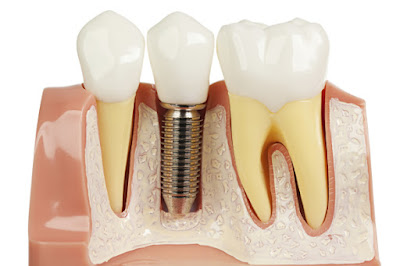Implant Dentistry Pennsylvania: Make Your Teeth Awesome
A dental implant which is also called an endosseous implant is basically a surgical component that can interface with skull bones or bones of the jaw. It forms support to the dental prosthesis such as a crown, denture or a bridge.
The modern Implant dentistry in Pennsylvania is based on the process of Osseous integration. This process includes materials such as titanium to form a bond with the bone. An implant fixture is first placed and allowed to Osseo integrate followed by the addition of dental prosthetics. The duration required for the healing of the osseous integration varies, before which the prosthetic is not to be attached to the implant.
The result of the Implant dentistry in Pennsylvania be it success or failure depends mainly on the person’s health who is undergoing the treatment. It may also depend on the drugs which affect the process of osseous integration or the health of mouth tissues. An evaluation is done about the stress that will be put in the implant during normal activities.
The final prosthetic can be of two types- fixed type of prosthetic where the denture and the teeth cannot be removed or the removable type of prosthetic where the denture can be removed by the patients. But an abutment is fixed in both the cases.
Connections are required to be changed or refreshed at a gap of one or two years when the implants are used to retain the complete denture.
Sometimes a powered Irrigator is used to clean the implants. Implant dentistry is beginning to be more common these days due to more plague and cavity formation which is a result of poor lifestyle.
Follow Media Brite Smile to learn more about its functions. Implant dentistry in Pennsylvania is very common and a huge number of dental clinics provide these services at an affordable price.
The modern Implant dentistry in Pennsylvania is based on the process of Osseous integration. This process includes materials such as titanium to form a bond with the bone. An implant fixture is first placed and allowed to Osseo integrate followed by the addition of dental prosthetics. The duration required for the healing of the osseous integration varies, before which the prosthetic is not to be attached to the implant.
The result of the Implant dentistry in Pennsylvania be it success or failure depends mainly on the person’s health who is undergoing the treatment. It may also depend on the drugs which affect the process of osseous integration or the health of mouth tissues. An evaluation is done about the stress that will be put in the implant during normal activities.
Prerequisites of Long Term Success Of Implants
- The position of the implants along with the number of implants is the key to produce long term health of a prosthetic. This is due to the fact that the stress produced and biomechanical force created during chewing is significant.
- Healthy bone and gingiva is important pre-requisite for the long term success of dental implants
The final prosthetic can be of two types- fixed type of prosthetic where the denture and the teeth cannot be removed or the removable type of prosthetic where the denture can be removed by the patients. But an abutment is fixed in both the cases.
Technique
Most of the implants have five basic steps for their placement-
-
SOFT TISSUE REFLECTION
-
DRILLING AT HIGH SPEED
-
LOW-SPEED DRILLING
-
PLACEMENT OF IMPLANT
-
TISSUE ADAPTATION
- Gingiva is adapted all around the implant and a thick healthy band of tissue is provided.
- In another procedure, implant and be “buried” in the tissue and by sealing the top of the implant by a cover screw. But in this method, a second procedure has to be conducted to remove the corkscrew and uncover the implant later on.
HEALING TIME
Osseointegration is necessary for an implant to be stable permanently. Recent researches have proved that the stability of the implant is more important determining factor than a fixed period of healing time. Thus the time that is allowed to heal is basically based on the density of the bone on which the implant is made. If the implant is able to withstand the high torque we do not find much difference in the implants that have been loaded immediately or those which have even loaded 3 to 6 months later.ROOT ANALOGUE DENTAL IMPLANTS
A root analog dental implant is a medical device which is used for the replacement of one or more roots of teeth just after the extraction. There is a limitation to the root analog implant that these can no longer be placed after the tooth has been lost or the soft and hard tissue has healed.MEDICAL USES
- Dental implants are mainly used to support dental prosthetics. The bone and implant integration can support physical loads for years without any failure.
- Dental implants can be used to retain dental prosthesis either as a fixed bridge or removal dentures. Bridges commonly connect more than one implant, to prevent the removal of prosthetics by the patients.
RECOVERY
The good integration of the implant begins the prosthetic phase. The prosthetic phase of the restoration of the implant requires technical expertise as well as surgical experience.MAINTENANCE
Once the implants are placed properly, they need to be cleaned with a Teflon instrument to remove any kind of plague that might have occurred. Care should be taken with dental flossing because of blood supply to the gingiva. The porcelain on the crowns can undergo discoloration, fracture or might require some repairing after almost 10 years.Connections are required to be changed or refreshed at a gap of one or two years when the implants are used to retain the complete denture.
Sometimes a powered Irrigator is used to clean the implants. Implant dentistry is beginning to be more common these days due to more plague and cavity formation which is a result of poor lifestyle.
RISKS AND COMPLICATIONS
- During the surgery and while the process of dental implant is going on, risks of infection excessive bleeding or necrosis of the tissue flap remains.
- While placing the implant, structures such as inferior alveolar nerve and maxillary sinus are in a risk of injury.
- The long term complications of the implant include risks such as poor gingival quality or a high smile line. Biomechanical risk factors are also present such as- geometry of implants do not support the teeth in the same way as the natural teeth do.
Follow Media Brite Smile to learn more about its functions. Implant dentistry in Pennsylvania is very common and a huge number of dental clinics provide these services at an affordable price.




Comments
Post a Comment